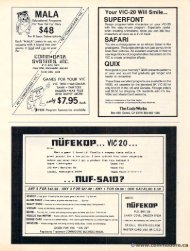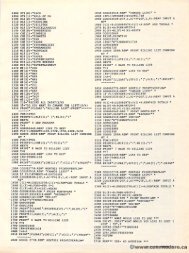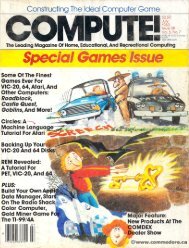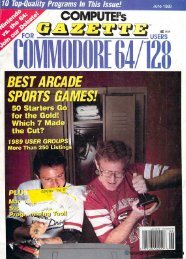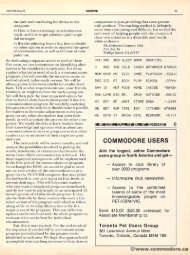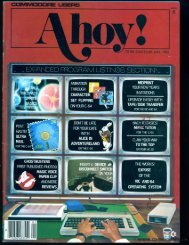May June 1980 - Commodore Computers
May June 1980 - Commodore Computers
May June 1980 - Commodore Computers
Create successful ePaper yourself
Turn your PDF publications into a flip-book with our unique Google optimized e-Paper software.
MAY/JUNE. I <strong>1980</strong>. 198O ISSUE 4. COMPUTE. 105 1O5<br />
OBSERVATIONS USING THE BAM MAP<br />
PROGRAM<br />
The BAM turns ofT off the bits when it allocates a<br />
sector. The BAM Map Program looks at these bits<br />
and if the bit is on (meaning it is free and has not<br />
been allocated) it will print either a "~~ "&" : " or a white<br />
sqare. By looking at the map you can determine<br />
how full or empty the disk is.<br />
Varying numbers of sectors.<br />
The reason for the varying number of sectors per<br />
track is LO to pack more data on the disk. Using the<br />
worse case which is 17 sectors per track and propagate<br />
throughout the disk would decrease the number<br />
of sectors per track by 95 sectors or 24k.<br />
Sectors not contiguous<br />
The sectors are in 255 byte blocks. A program<br />
file, which is stored in 255 bytes, is not written<br />
on the disk contiguously but wrillen written approximately<br />
one-halftrack apart. . Using thee BAM program, m , you<br />
can see when youu save a program on a empty disk,<br />
that DOS will save the first 255 bytes on track 17<br />
secLOr sector 0, the second 255 bytes on sector 10, the<br />
third 255 bytes on sector 3, and so on. The purpose<br />
of these gaps is to speed up the processing by not<br />
S0<br />
El<br />
C2<br />
T3<br />
0 4<br />
R5<br />
6<br />
~<br />
to<br />
II<br />
TRACKS TRftCKS 11111111112222222222333333<br />
1234567891312345678901234567891312345<br />
123456785012345678581234567B90I3345<br />
12<br />
13<br />
14<br />
15<br />
16<br />
17<br />
IS 18<br />
19<br />
2Q 20 wsmmmmmmmmt—free blks= s?e<br />
CKS TRACI(S 111111111112222222222333333<br />
U11111112222222222333333<br />
12343678901234567890123456765012345<br />
12345678901234567890123456789012345<br />
se Sfi<br />
I<br />
El<br />
I<br />
C2<br />
II<br />
I<br />
T3<br />
04<br />
• I<br />
I<br />
R5<br />
6<br />
• I<br />
I<br />
7<br />
8 "<br />
I<br />
I<br />
9<br />
18 10<br />
I<br />
I<br />
11 II<br />
12 •<br />
I<br />
I<br />
13<br />
14 I "<br />
I<br />
I<br />
15 I<br />
It 16 I • I<br />
17 I<br />
18 I<br />
,-- 19 I • .--<br />
I<br />
I I DR*=EMPTV<br />
OR*=EMPT'y'<br />
20 I<br />
l"FREE :REE BLKS= £lLKS= @ £I<br />
References:<br />
Parsons, s, James Jamcs C, C .. "Display y Track and d Sector", Scctor", <strong>Commodore</strong><br />
Newsletter Ncwslclle!' Vol. 1I Number 8, January <strong>1980</strong>.<br />
.<br />
<strong>Commodore</strong> Business ti ll Machines, <strong>Commodore</strong> CBM C Dual Floppy<br />
py<br />
Disk Model 2040 User U SCI' Manual, al , July J y 1979.<br />
waiting for a full rotation of the disk. If the pro<br />
waiting for a full rotation of the disk. If the pro<br />
gram was written contiguously after each write, , DOS<br />
would have to wait an entire rot rotation of the disk to<br />
write the next sequental sector. Thus, when one is<br />
looking g at the BAM Map, one will see where alternating<br />
sectors are allocated.<br />
ing sectors are allocated.<br />
Allocation of sectors<br />
DOS allocates disk space very efficiently. SecLOrs<br />
Sectors<br />
are allocated around the directory (track 18) . This<br />
are allocated around the directory (track 18). This<br />
reduces the read/write head movement because it reads<br />
the directory first, , then reads the fil file. By having the<br />
file e close to the directory, head movement is reduced. .<br />
Where sectors are allocated<br />
When you delete the first program on a full disk,<br />
the BAM Map will show free sectors near the directory.<br />
When you save a new program, it will start by<br />
allocating those free sectors nearest the directory and<br />
will start filling in where you deleted the old file.<br />
If thee new program is larger than the old program,<br />
it will tJ'>' try to (o allocate sectors further and further<br />
from thee directory. By using this allocation technique,<br />
the need for a disk compress is eliminated.<br />
PROGRAM EXPLANATION<br />
PROGRAM EXPLANATION<br />
100-170 Initialization<br />
180-190 Which drive?<br />
200-430 Prints s the BAM Map outline. .<br />
100 REM* REI·l* BLOCK ACCESS METHOD NETHOD DUMP *<br />
110 REM* WRITTEN BY TOM T011 CONRAD *<br />
120 REM*<br />
130 REM* RE~I*<br />
140 REM* INITIALIZATION<br />
I NITIAL IZATION *<br />
150 DIM A(4)<br />
160 NL$=CHR$(0)<br />
170 T=0: REM REI1 TOTAL FREE BLOCKS<br />
175 REM* REI1* WHICH DRIVE *<br />
180 PRINT"fiVHHDRIVE? "fifttWDRIVE?""<br />
190 GET D$: IF D$="" GOTO 190<br />
195 REM* PRINTS THE BAM MAP ~lAP OUTLINE *<br />
200 PRINT"fi rTRACKSr LTRACKSf 111111111122222<br />
-.22222333333"<br />
, 210 PRINT" 123456789012345678901234567<br />
8 -.89012345"<br />
,89012345"<br />
220 PRINT"! PRINT"} $$$SS$$$SS$S$$$$SSSSSSSSSSS<br />
$$$$$$$$$$$$$$$$$$$$$$$$$$$<br />
-,$$$$$$$S"<br />
,$$$$$$$$"<br />
230 PRINT"rSr0_L<br />
"LSf0.'. '<br />
, 1"<br />
240 PRINT"xEfll<br />
".r.Efl.'.<br />
,<br />
-i<br />
1"<br />
250 PRINT"j:Cr21<br />
".r.Cf2.'.<br />
, 1 "<br />
260 PRINT"rTf31<br />
".r.TD.'.<br />
, 1"<br />
270 PRINT"iOr4J.<br />
"Lof4.'. ,<br />
, 1 "<br />
280 PRINTnrRf51<br />
".r.Rf5.'.<br />
, 1 "<br />
290 PRINT" " 61 6.'.<br />
,<br />
-i ■1 "<br />
300 PRINT" 71 7.'.<br />
, 1"



